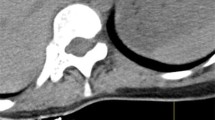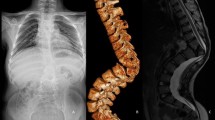Summary
One CT-scan at the central part of the vertebral body of the apical vertebra of 32 patients with right convex thoracic idiopathic scoliosis and one CT-scan of either T8 or T9 of 22 normal subjects are included in this study. The position of the aorta in relation to the apical vertebra of the scoliotic patients and the corresponding vertebra of the normal subjects was determined at the horizontal plane. The mean lateral translation of the aorta in relation to the mid axis of the vertebral body increased from 19.7±4.3 mm in the normal group to 26.4±4.1 mm in the scoliotic group (p = 0.0001). In the normal group the aorta was located 41.7±8.6 mm in front of a perpendicular line to the mid axis of the vertebral body and in the scoliotic group this distance was reduced to 30.0±9.0 mm making the position of the aorta more posterior in the scoliotic group (p = 0.0001). This was in accordance with a decreased mean kyphosis-lordosis index from 0.53 ± 0.06 in the normal group to 0.46±0.07 in the scoliotic group (p−0.01). The position of the aorta, also expressed as the angle formed between the aorta and the vertebral body, the “aorto-vertebral angle”, was increased from 24.4°±6.9° in the normal group to 41.4°±8.4° aorto-vertebral angle did not change significantly with increasing Cobb angle (p = 0.26) but was positively correlated to the vertebral rotation (p = 0.0001). An estimation of the length of the intercostal arteries revealed a significantly greater R (right)/L (left) index in the scoliotic patients 1.18±0.11 than in the normal subjects 1.08±0.06 (p−0.0003). It is concluded that the rotation and the anterior displacement of the vertebral body in scoliosis result in a deviation of the aorta along the left (concave) side of the vertebral body to a more posterior position relative to the vertebral body with a possible increased length of the intercostal artery on the right (convex) side.
Résumé
La coupe tomodensitométrique passant par le milieu du corps de la vertèbre du sommet de courbure chez 32 patients porteurs d’une scoliose thoracique idiopathique à convexité droite et une coupe en T8 ou T9 chez 22 sujets normaux ont été inclues dans cette étude. Les rapports de l’aorte avec la vertèbre apicale chez les patients scoliotiques, et avec la vertèbre correspondante chez les sujets normaux, ont été établis dans un plan axial. Le positionnement latéral moyen de l’aorte par rapport à l’axe médian du corps vertébral passait de 19,7±4,3 mm dans le groupe normal à 26,4±4,1 mm dans le groupe avec scoliose (p = 0,0001). Dans le groupe normal le plan frontal de l’aorte perpendiculaire à Taxe médian du corps vertébral était situé à 41,7±8,6 mm. et dans le groupe avec scoliose cette distance était réduite à 30,0±9,0 mm, traduisant une position plus dorsale, de l’aorte (p = 0,0001). Ceci était corrélé avec une diminution de l’index moyen de cypholordose, de 0.53±0,06 dans le groupe normal à 0,46± 0,07 dans le groupe avec scoliose (p = 0,01). La position de l’aorte était également exprimée par l’angle entre l’aorte et le corps vertébral, angle aorto-vertébral. lequel passait de 24,4°±6,9° dans le groupe normal à 41,1°±8,4° chez les patients scoliotiques (p = 0.0001). L’angle aorto-vertébral n’était pas significativement modifié par l’augmentation de l’angle de Cobb (p = 0,26) mais était corrélé à la rotation vertébrale (p = 0,0001). L’estimation de la longueur des artères intercostales révélait chez les patients scoliotiques une augmentation significative de l’index R (droite) / L (gauche) à 1,18 ±0.1 1 contre 1,08±0,06 chez les sujets normaux (p = 0,0003). Nous concluons que la rotation et l’avancée du corps vertébral dans la scoliose provoque un déplacement dorsal de l’aorte le long du bord gauche du corps vertébral avec une probable augmentation delongueur de l’artère intercostale du côté droit (convexe).
Similar content being viewed by others
References
Aaro S, Dahlborn M, Svensson L (1978) Estimation of vertebral rotation in structural scoliosis by computer tomography. Acta Radiol Diagn 19: 990–992
Aaro S, Dahlborn M (1980) Estimation of vertebral rotation and the spinal and rib cage deformity in scoliosis by computer tomography. Spine 6:460–467
Adams W (1865) Lectures on the pathology and treatment of lateral and other forms of curvature of the spine. J. Churchill & Sons, London
Agadir M, Sevastik B, Sevastik J, Persson A, Isberg B(1988) Induction of scoliosis in the growing rabbit by unilateral rib-growth stimulation. Spine 13: 1068–1069
Agadir M, Sevastik B, Reinholt FP, Perbeck L, Sevastik J (1990) Vascular changes in the chest wall after unilateral resection of the intercostal nerves in growing rabbits. J Orthop Res 8: 283–290
Normelii H, Sevastik J, Wallberg H (1986) The thermal emission from the skin and the vascularity of the breasts in normal and scoliotic girls. Spine 11: 405–408
Normelii H, Sevastik J. Akrivos J (1985) The length and ash weight of the ribs of normal and scoliotic persons. Spine 10: 590–592
Pal GP (1991) Mechanism of production of scoliosis. A hypothesis. Spine 16: 288–292
Stokes IAF, Danserau J. Moreland MS (1989) Rib cage asymmetry in idiopathic scoliosis. J Orthop Res 7: 599–606
Taylor JR (1986) Vascular causes of vertebral asymmetry and the laterality of scoliosis. Med J Austral 144: 533–535
Woodrough RE (1976) Thermographic screening for scoliosis in adolescents. Acta Thermogr 1: 63–66
Author information
Authors and Affiliations
Rights and permissions
About this article
Cite this article
Sevastik, B., Xiong, B., Hedlund, R. et al. The position of the aorta in relation to the vertebra in patients with idiopathic thoracic scoliosis. Surg Radiol Anat 18, 51–56 (1996). https://doi.org/10.1007/BF03207763
Received:
Accepted:
Issue Date:
DOI: https://doi.org/10.1007/BF03207763




